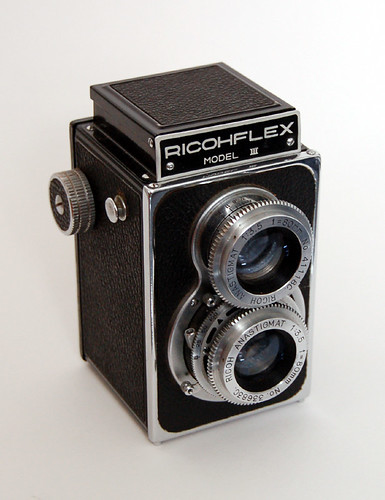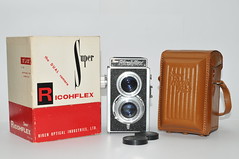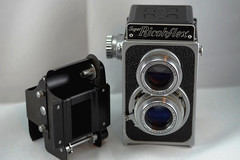Ricohflex (geared lens)
The Ricohflex models of the 1950s were a series of 6x6 TLRs made by Riken Optical Industries (Ricoh) with geared rings around the front of the taking and viewfinder lenses for synchronous focusing.
The simplified design and a streamlined manufacturing process allowed Ricoh to greatly increase production, and offer a TLR at an attractive low price.[1]
List of models:
- Ricohflex III
The Ricohflex III of 1950 had a pair of similar Ricoh Anastigmat 1:3.5 f=80mm lenses. Arched "Ricohflex" lettering on nameplate.
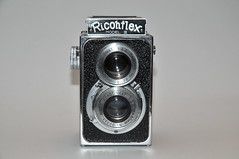
|
| Ricohflex III image by David Donnadieu (Image rights) |
- Ricohflex IIIB
The production volume was more than 10,000 units per month. For this, Riken used a conveyor belt assembly line .

|
| Ricohflex IIIB Click for more pictures image by David Donnadieu (Image rights) |
- Ricohflex IIII / IV
The first ones are labelled IIII which was later changed to the correct Roman Numeral IV.
- Ricohflex VI
The Ricohflex VI had a combination of Anastigmat camera lens and Viewer finder lens. It was also sold as the Victaflex.[2]
In 1953 this sold at the competitive price of USD $49.95 including case.[3]

|
| Ricohflex VI Click for more pictures image by David Donnadieu (Image rights) |
- Ricohflex VII (Riken or Seikosha shutter)
The Ricohflex VII was introduced in 1954. It features a Ricoh Anastigmat 1:3.5/8cm front-element focusing lens geared to the Ricoh Viewer 1:3,5/8cm lens for viewfinder focusing. The lens goes from f/3.5 to 16 without click stops, beyond f/16 it not marked. The diphragm has 9 blades. It had a Riken shutter with B mode and speeds from 1/25-1/100, or a Seikosha-Rapid shutter 1-1/500. The riken shutter is synchronized for [[Flash_sync#M_sync |M-type flash bulbs] The shutter uses the same lever to cock the shutter (pull up) and fire the shutter (push down). The camera uses 120 film with manual advance (red window) and no double xposure prevention. It can take 35mm with an adapter. The variants are:
- Ricohflex VIIS (1955)
- Ricohflex VIIM (1956) with shutter speed of 1/10-1/300
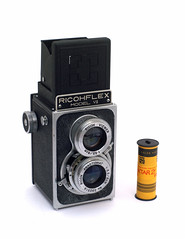
|
| Ricohflex VII image by Steve Harwood (Image rights) |
- Super Ricohflex
This camera was introduced in 1956
There is a minimum of 4 different versions of the Super Ricohflex, with different shutters and front plates. This camera was primarily designed for the U.S. market. It's the most sold Ricohflex.
Lens is an Ricoh anastigmat 80mm/f3.5, same as in the VII but with coated surfaces, with a matching geared viewing lens.
Riken shutters are the most common with speeds of B-10-25-50-100 and 200 and 300 in the late models; Seikosha shutters are les common (B-1 to 500).
Shutters were syncronized for electronic X-flash with a PC connector on the shutter and a cold shoe on the side of the camera.
An accessory called "Color Back" to enable the camera to use 35mm film was also offered, it came with a take-up 35mm canister and a special film counter for vertical 35m exposures.
Another accessory called "Auto stop" prevented waste of film or double exposures in 35mm.
|
|
|
- Ricohflex Holiday
Identical to the VII with flash shoe.
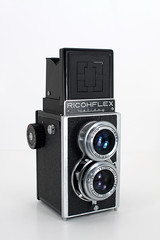
|
| Ricohflex Holiday image by Jason Hull (Image rights) |
- Ricohflex Million
Similar to model VII with shutter Riken (B-1-300) and hot shoe and PC connector for electronic flash
- Ricohflex New Million
Various copies of the geared-lens Ricohflex were made, including the following:
- Akumiflex
- one version of the Cosmoflex
- Da Lai (Popular) - a 1957 Chinese prototype produced as the Chang Hong II (Rainbow)
- Dorimaflex
- Halina A1
- Koniken
- Monade Flex
- Rolex
- Ruvinalflex
- Silverflex
- Sharpflex Model S (clone of a Silverflex)
- Tsubasaflex or Tubasaflex
Bibliography
- Hayashi Teruaki (???). "Sengo no kamera 1: Nigan-refu kamera" (??????1·???????, Postwar cameras 1: TLR cameras). Kamera Rebyū: Kurashikku Kamera Senka (カメラレビュー クラシックカメラ専科) / Camera Review: All about Historical Cameras no.14, October 1989. No ISBN number. Rikō kamera no subete (リコーカメラのすべて, special issue on Ricoh). Pp.26–32.
Links
- Ricohflex / Diacord / Ricohmatic 6x6 TLRs at Greg Erker's [1]
- Ricohflex VII user manual at Butkus.org
- Super Ricohflex user manual at Butkus.org
In French:
- Ricohflex VII and Ricohflex Super at www.collection-appareils.fr
- Ricohflex IIIB at www.flickr.com
- Super Ricohflex at www.flickr.com
In Japanese:
- Ricoflex III profiled (or in Google Translate English) from Ricoh's film camera history pages
- Ricohflex VI and more pictures at Hayata Camera Laboratory
- Ricohflex VII at Ito Sadanobu's camera collection
Notes
- ↑ Ricoh claims that this model was the first Japanese camera built on a conveyor-belt production line(PDF), at its company history pages.
- ↑ Seen at online auction 1/2018
- ↑ An advertisement in the May, 1953 Popular Photography (Vol. 32, No. 5; pg. 133) also highlighted an available Ricohkin 35mm film adapter.
